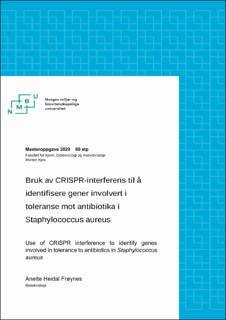| dc.contributor.advisor | Kjos, Morten | |
| dc.contributor.author | Frøynes, Anette Heidal | |
| dc.date.accessioned | 2020-10-05T09:41:00Z | |
| dc.date.available | 2020-10-05T09:41:00Z | |
| dc.date.issued | 2020 | |
| dc.identifier.uri | https://hdl.handle.net/11250/2681115 | |
| dc.description.abstract | Staphylococcus aureus, ofte kalt gule stafylokokker, er en svært viktig human bakteriell patogen. Bakterien forårsaker en rekke humane kliniske sykdommer som strekker seg fra lokaliserte, avgrensede hud- og bløtvevsinfeksjoner til bakteriemi, infeksiøs endokarditt og toksisk sjokksyndrom. I behandlingen av S. aureus-infeksjoner benyttes det i dag flere ulike antibiotika, hvor glykopeptidantibiotika benyttes i behandlingen av livstruende infeksjoner forårsaket av multiresistente S. aureus. Glykopeptider fungerer ved å inhibere bakteriell celleveggsyntese via blokkering av peptidoglykansyntesen, men derivater av glykopeptider kan også ha andre virkningsmekanismer som er lite karakterisert.
Antibiotikaresistens gjør behandling av S. aureus-infeksjoner problematisk, og det knyttes spesielt utfordringer til methicillin-resistente S. aureus (MRSA) og vancomycin (glykopeptid)-resistente S. aureus (VISA og VRSA). For å kunne bekjempe dette er det avgjørende å øke kunnskapsnivået rundt gener involvert i antibiotikaresistens og toleranse hos S. aureus. For dette trengs det nye forskningsverktøy som kan brukes til dette formålet. For S. aureus ble det nylig utviklet et CRISPR interferenssystem (CRISPRi), som gjør det mulig å spesifikt nedregulere genekspresjon hos målgener. I denne oppgaven var et av hovedmålene å finne ut om CRISPRi-systemet og et hel-genom-CRISPRi-deplesjonsbibliotek kunne benyttes til å identifisere gener som er involvert i toleranse mot antibiotika, og da spesifikt transkripsjonshemmeren rifampicin og lipoglykopeptidet dalbavancin. CRISPRi viste seg å fungere dårlig til å studere rifampicinresistens. Derimot ved Illuminasekvensering av CRISPRi-deplesjonsbiblioteket (CRISPRi-sek) før og etter dalbavancinbehandling ble det i dette arbeidet identifisert flere gener involvert i toleranse for dalbavancin. Flere av de identifiserte genene er allerede kjent for å være involvert i toleranse for glykopeptider og lipopeptider, som for eksempel genene ezrA, vraF og SAOUHSC_00678. I tillegg ble kapB identifisert som et nytt gen som både ved deplesjon og delesjon gjorde cellen mer sensitiv for dalbavancin. Videre ble også CRISPRi-biblioteket benyttet for å selektere frem mutanter med økt dalbavancintoleranse, og identifiserte med dette sagB og aroB. sagB er allerede kjent for å være involvert i glykopeptidtoleranse. Også deplesjon av genet aroB førte til økt dalbavancinresistens hos cellen, og dette ledet til oppdagelsen av at nedregulering av gener i chorismate-biosyntesen førte til resistensøkning. Generelt viste denne oppgaven at CRISPRi-deplesjonsbiblioteket kan brukes til å identifisere gener involvert i antibiotikatoleranse, og førte spesifikt til identifisering av kjente og ukjente gener som er involvert i toleranse for dalbavancin i S. aureus som legger grunnlaget for videre mekanismestudier. | en_US |
| dc.description.abstract | Stahpylococcus aureus, is a very important human bacterial pathogen. The bacterium causes a wide range of human clinical illnesses from localized skin- and soft tissue infections to bacteremia, infectious endocarditis and toxic shock syndrome. Several antibiotics are used in the treatment of S. aureus-infections, whereas glycopeptide antibiotics are used in the treatment of life-threatening infections caused by multi-resistant S. aureus. Glycopeptides work by inhibiting bacterial cell wall synthesis by blocking the peptidoglycan synthesis, however, some glycopeptides may also work by other modes of action that are less well known.
Resistance to antibiotics is problematic for treating infections caused by S. aureus, and there are particularly challenges associated with methicillin-resistant S. aureus (MRSA) and vancomycin (glycopeptide) resistant S. aureus (VISA and VRSA). To deal with this problem, it is crucial to increase the level of knowledge about genes involved in antibiotic resistanceand tolerance in S. aureus. This requires new research tools that can be used for this purpose. A CRISPR interference system (CRISPRi) was recently developed for S. aureus, making it possible to specifically downregulate target gene expression. One of the main goals of this thesis was to investigate whether the CRISPRi-system and a whole-genome-CRISPRidepletion library could be used to identify genes involved in tolerance to antibiotics by studying the transcription inhibitor rifampicin and the lipoglycopeptide dalbavancin. CRISPRi worked poorly in the study of rifampicin resistance. In contrast, by Illumina sequencing the CRISPRi depletion library (CRISPRi-seq) before and after dalbavancin treatment, we identified several genes involved in tolerance to dalbavancin. Several of the genes identified were already known to be involved in tolerance to glycopeptides and lipopeptides, including the genes ezrA, vraF and SAOUHSC_00678. kapB was also identified as a new gene that made the cell more sensitive to dalbavancin both by depletion and deletion. Moreover, the CRISPRi library was used to select mutants with higher tolerance to dalbavancin, leading to the identification of sagB and aroB. sagB is already known to be involved in tolerance to glycopeptide antibiotics. Also, depletion of the aroB gene made the cell more resistant to dalbavancin, which further led to the discovery that downregulation of genes in the chorismate biosynthesis causes increased resistance. In general, the results in this work shows that the CRISPRi depletion library if useful for identifying genes involved in tolerance to antibiotics. Specifically, known and unknown genes involved in tolerance to dalbavancin in S. aureus were identified and this provides the basis for further mechanism studies. | en_US |
| dc.language.iso | nob | en_US |
| dc.publisher | Norwegian University of Life Sciences, Ås | en_US |
| dc.rights | Attribution-NonCommercial-NoDerivatives 4.0 Internasjonal | * |
| dc.rights.uri | http://creativecommons.org/licenses/by-nc-nd/4.0/deed.no | * |
| dc.subject | CRISPR interferens | en_US |
| dc.subject | Staphylococcus aureus | en_US |
| dc.subject | Antibiotikatoleranse | en_US |
| dc.subject | Dalbavancin | en_US |
| dc.subject | Vancomycin | en_US |
| dc.subject | Rifampicin | en_US |
| dc.title | Bruk av CRISPR-interferens til å identifisere gener involvert i toleranse mot antibiotika i Staphylococcus aureus | en_US |
| dc.title.alternative | Use of CRISPR interference to identify genes involved in tolerance to antibiotics in Staphylococcus aureus | en_US |
| dc.type | Master thesis | en_US |
| dc.description.version | submittedVersion | en_US |
| dc.source.pagenumber | 104 | en_US |
| dc.description.localcode | M-BIOTEK | en_US |

